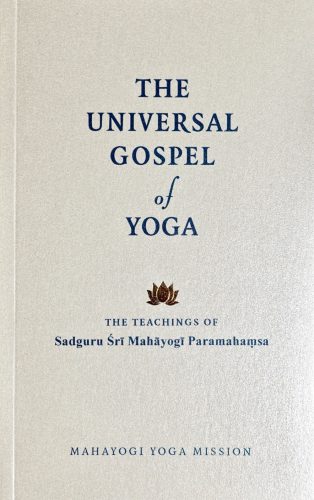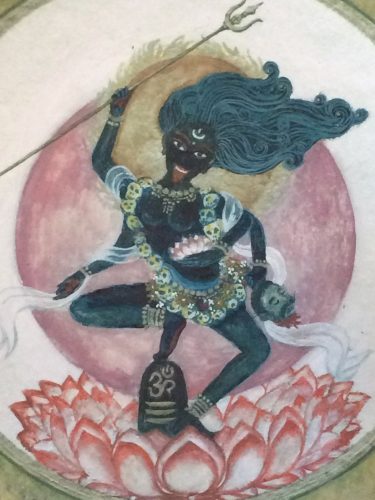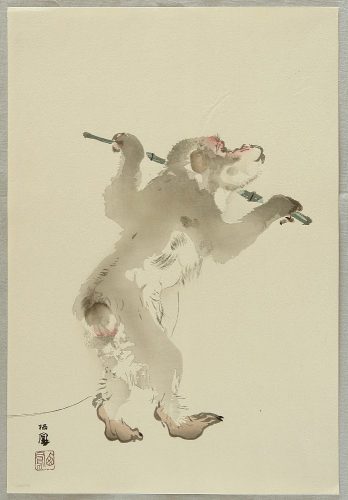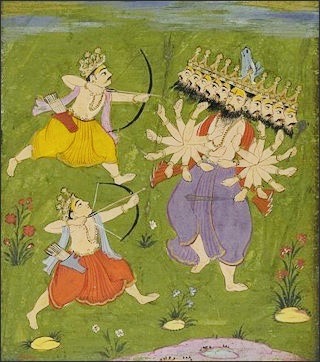
This is not a pipe. 1929 —René Magritte
Talk at the End of the Asana & Meditation Class
Sunday, April 3rd 2022
Yoga is “Science of the Mind”—Asana, an Instrument
&
Pranavadipa Vol. 89, April 8th, 2022
When referring to Yoga, oftentimes and perhaps especially in modern times, what comes to mind is the practice of various postures—like the asana that we practice during the Asana & Meditation class. But, what we learn from Shri Mahayogi is that originally, and now still, Yoga is actually a science of the mind. And asana is just one part, one practice contained within it. In the class, we practice asana as the preparation for the meditation time at the end.
Perhaps, very often, one of the things many of us may hope for is that, in one way or another, through meditation we may find some peace and calm, or freedom, from the many, many stresses coming from our daily lives. Shri Mahayogi has pointed out to us that everyone seeks for some kind of everlasting happiness, some perfectly peaceful state, or to be free (which could mean from just about anything), which is something we can probably all observe—but as long as we find ourselves still seeking it in various things, it also means we haven’t yet really been able to find it.
From Shri Mahayogi we learn that, since ancient times, the yogi looked into this matter. They found that there is something that seems to get in the way and become an obstacle…and that is the mind. The yogi found that the mind is always getting disturbed by one thing or another—which is what becomes the disturbance we call “stress,” that we are then constantly trying to deal with and resolve. But, the yogi also observed that, if the mind gets disturbed, if it is experiencing stress, there is always a reason for it, a cause. That cause is found within ourselves. And there are various causes that are common to everyone.
To give an example, in the Yoga Sutra, one of the principal texts of Yoga, it is pointed out that attachment towards the things we like and aversion towards the things we dislike are a huge cause of stress. If we like something, we want more of it, want to keep it, don’t want to lose it. If we don’t like something, we want to get rid of it, avoid it, escape from it. All of our efforts to ensure that we can obtain and maintain the things we want, while at the same time, get rid of and stay free from the things we don’t want, keep us busy going to great lengths to try to control situations and circumstances around us that are simply out of our control—stress—and then when things inevitably don’t go according to plan or how we wish for—more stress!!
The yogi found that, if we can observe the cause of that stress within ourselves, then, once we know what it is, we can work to remove that cause. By doing that, little by little, we can experience that this stress can come to be resolved for good, rather than just be temporarily soothed.
One of the big challenges though, is that most of the time we are just in the midst of experiencing all kinds of stresses, worries and anxieties, and immediately look for the cause of it all outside of ourselves—it’s because of the situation I’m in, it’s because of the environment I have to work in, it’s because of all these things that happened to me, it’s because of all the things I have to do, it’s because of that person, etc. And then, more often than not, we try to force changes in those things outside of ourselves. But when it comes to things outside of ourselves, there is always a complex myriad of factors at play, that are impossible to predict as we try to shape and change things according to our wishes and preferences, so inevitably when the next situation pops up unexpectedly, without having made any change within ourselves, the stress that we experience will not have changed either.
It is such a strong habit the mind has, to look outside of ourselves, that it seems to be rather difficult to actually reflect on ourselves, to look for a cause within ourselves, and then change something about ourselves! Indeed, that may be one of the mind’s strongest tendencies to go against. But, through Yoga, through the science of the mind, as Shri Mahayogi assures us again and again, we learn that this is exactly what must be done if we would like to truly resolve and become free from all of our disturbances, or stresses, which Shri Mahayogi and the great Yogi of the past have found is indeed possible and is actually our natural, inherent state.
Here’s where I think the practice of asana is a great help and why Shri Mahayogi teaches it to us as a foundational preparation. Through practice of asana, and the training through focusing on the breath, the way we learn in the class that comes from Shri Mahayogi’s own experience and mastering of asana, gradually the mind can come to settle down, enough to gain a little more clarity. And as that happens, our ability to face, and objectively and scientifically observe our own mind, gradually expands.
There is a question and answer that illustrates the important link between the asana and the focus on the breath in the way Shri Mahayogi teaches us. The following is an excerpt from the exchange of question and answer that arose at the end of the very last class that Shri Mahayogi directly instructed in Kyoto, Japan, back in March 2019.  (You can read it and more in this month’s issue of Pranavadipa Vol. 89, published April 8th.)
(You can read it and more in this month’s issue of Pranavadipa Vol. 89, published April 8th.)
Question: Shri Mahayogi always reminds us to still the physical body and focus on the exhalation during asana. Please tell us the reason why, once again.
MASTER: In order to realize the Truth, one must control the mind. However, it is very difficult to control the mind. In the scripture, Bhagavad Gita, Arjuna, the disciple of God Krishna, asks God Krishna: “Controlling the mind is precisely as difficult as trying to harness the wind; what should I do?” Then Krishna responds, “You can accomplish it through constant discipline and dispassion.” Constant discipline means to train again and again. Study and learning is included in that. “Constant discipline” applies to the whole of practice. And another one is dispassion—it means non-attachment; it indicates that you should make the mind empty as if it were transparent, or create a mind that doesn’t have any obsessions or attachments, like it is empty. Yet it is very difficult to try to restrain the mind. It is there then that the practitioners of Yoga [in ancient times], who had pragmatically mastered it through experiencing the close connection between breath and mind, realized that by controlling the breath, the mind can be controlled. They discovered that rather than trying to control the mind directly, they can first control the breath, and consequently the mind follows; since the breath too is a part of the autonomic system, for example, when emotions are disturbed—excited, angry, or crying—the breath also gets out of order according to the various fluctuations of the mind; it is difficult to always sustain a calm breath, so then, they attempted to control the physical body in order to control the breath—that is how they discovered that through this distinctive method called asana, they can change the rhythm of the breath. Therefore, asana does not merely have the purpose of maintaining health, but its purpose of transforming the breath is hidden within. In fact, if one devotes oneself to practice asana daily for many years, thoroughly and to the hilt, the breath transforms and simultaneously, the mind transforms; the mind becomes such that it does not get disturbed nor is it affected [by anything]; even if some stimuli come, the mind retains its calm, and it always remains the same. This is because the breath does not become disorderly, and simultaneously, the mind too is unaffected. This is the wisdom that has been cultivated through the actual, empirical practice of Yoga. Therefore, the purpose of asana lies in creating this foundation.
If I reflect on what I am being taught through the asana that I am learning through Shri Mahayogi, I have to say that I believe that through continued and correct practice of asana in its original form that Shri Mahayogi teaches, even if there are internal things that disturb our minds, like strong memories that may be invisibly playing into our thoughts and emotions, these too can be affected and transformed through this focus on the breath. There is really probably not much difference between the situations in our daily lives that push and pull us, and the memories that we hold onto that push and pull us.
I am learning through Shri Mahayogi and the teaching of Yoga, for example, that what we consider to be the factual knowledge within our mind, is actually all shaped by our perceptions of various experiences and how we categorize them in various levels of pleasing or displeasing. You and I may encounter the exact same situation. I may experience it positively, and then my mind will categorize it as “desirable.” You may experience it negatively, and then your mind will categorize it as “undesirable.” The situation itself is not necessarily either of those things, but based on each of our experiences, our minds will start to create respective beliefs about the same thing. And we will both believe our belief to be the true one! And of course, every time we encounter a similar situation, we won’t see it objectively at all, but through the lens of the belief we’ve already created. So much content of what is in our mind is created from seeing through these various lenses and establishing beliefs upon more beliefs that come to paint the background of our minds. Memory is the same way, it is just a shadow of a past experience. All of this seems to prevent us from being able to see and understand things as they are.
From what I am being taught through asana, I feel that we really do have the chance to start to challenge and test the validity of what we believe to be true, what we think we understand. We can test out pushing and going beyond the limits that our minds put in place for us, in simple ways. To give an example, with the long exhalation, the sensation may come, I need to inhale right now! Why? Because if I don’t, I might die!! The mind can be very dramatic that way. These aren’t necessarily thoughts or a dialogue that is happening in the mind, but like sensations that, if observed quietly, may reveal these beliefs hiding underneath.
So then, we can challenge those beliefs in the practice of asana itself! Not by thinking or analyzing, but by using the physical body and the breath to do something differently. And see what happens. See if our limits are our limits, if what we believe to be true is true, through action. Observing and testing over and over, again and again. After all, no scientist collects only one sample of data!
We hold onto so many beliefs, including memories, that result in limitation and unnecessary stress for ourselves. Let’s follow the way Shri Mahayogi is leading us and let’s challenge and shake the very structure of that mechanism of the mind through practice of asana!
~ Sadhya
*
To be able to receive this teaching from Shri Mahayogi, and to receive the instruction in asana from Shri Mahayogi, whether we have received it directly from him, or are receiving it from him through his direct disciples, or both—is a BLESSING. No matter the way, it seems the authentic practice of asana coming from ancient times, with its original purpose of transforming the mind, is what Shri Mahayogi is making concrete and practicable for us!
There are many other great teachings coming through the question and answer that continued at the end of the final class that Shri Mahayogi directly instructed in Kyoto, 2019, and in the Satsangha that followed that evening, all of which is now published in Pranavadipa Vol. 89. (Satsangha, which is a gathering of Truth with Shri Mahayogi, has been held regularly in Kyoto, though it is currently on pause until further notice.) And additionally, there are two Testimonies coming from the actual practice and experience of two different practitioners, both of which in different ways give us excellent material filled with concrete and practical examples of what it might look like to further face this mind, the way it can cause us so much trouble and stress, and some very practical ways of working towards resolving these causes in daily life and through meditation.
To make a financial contribution, visit our CONTRIBUTION PAGE.
Visit and share our WELCOME PAGE to join our online classes.




 “…Simply put, when the mind becomes still,
“…Simply put, when the mind becomes still,






